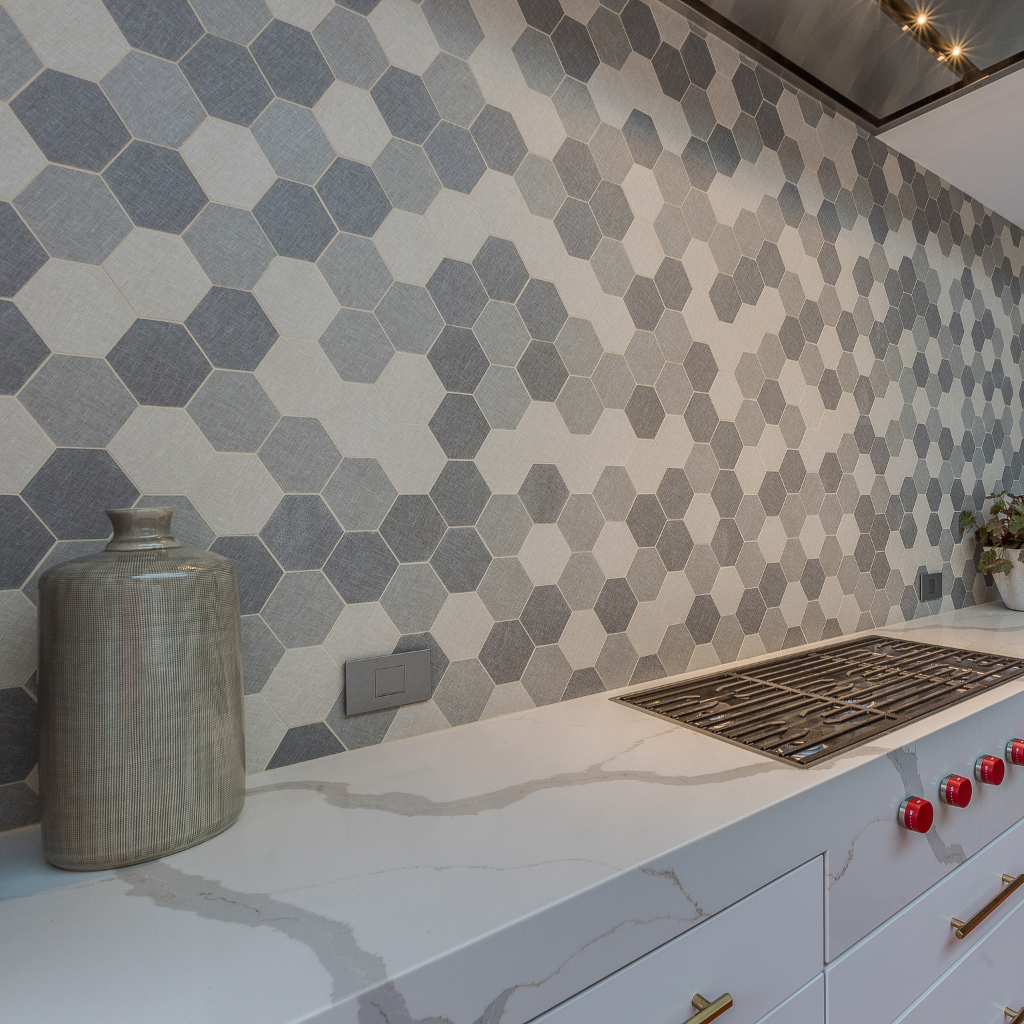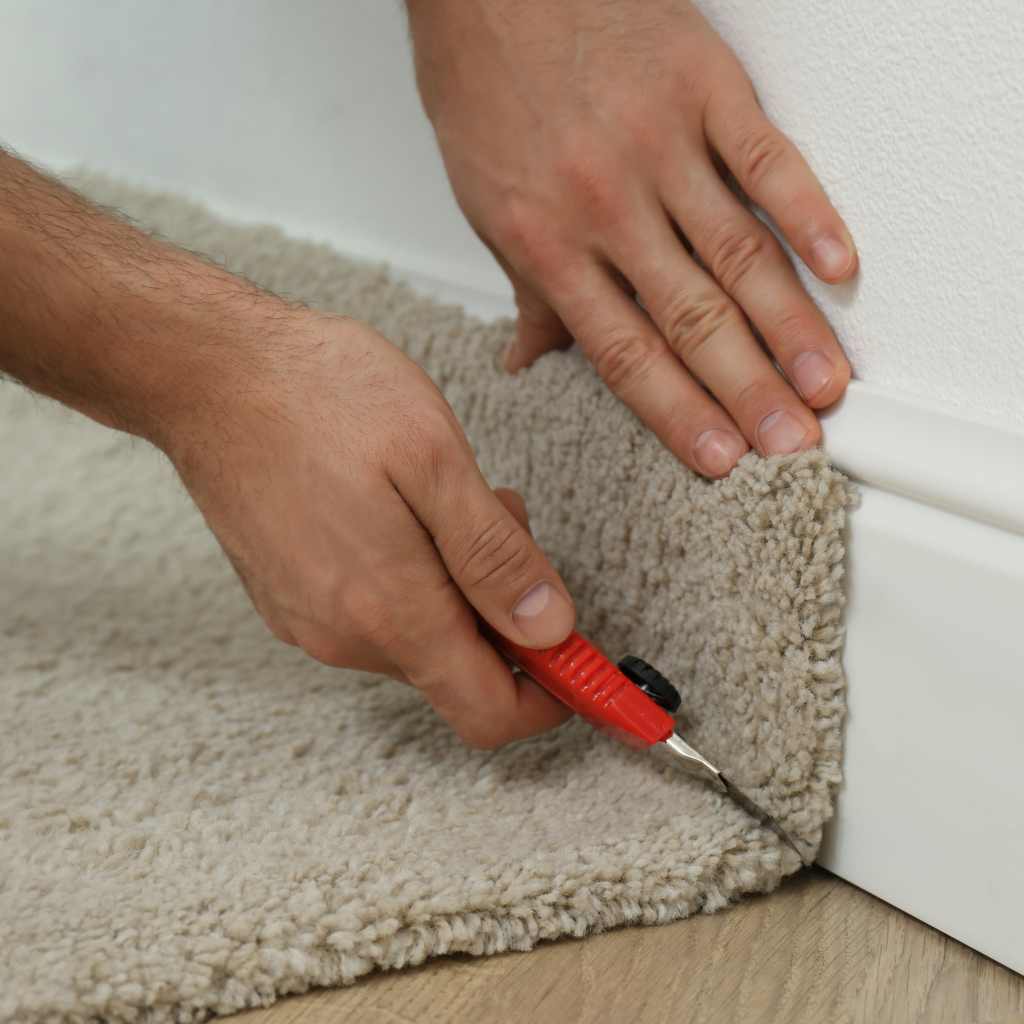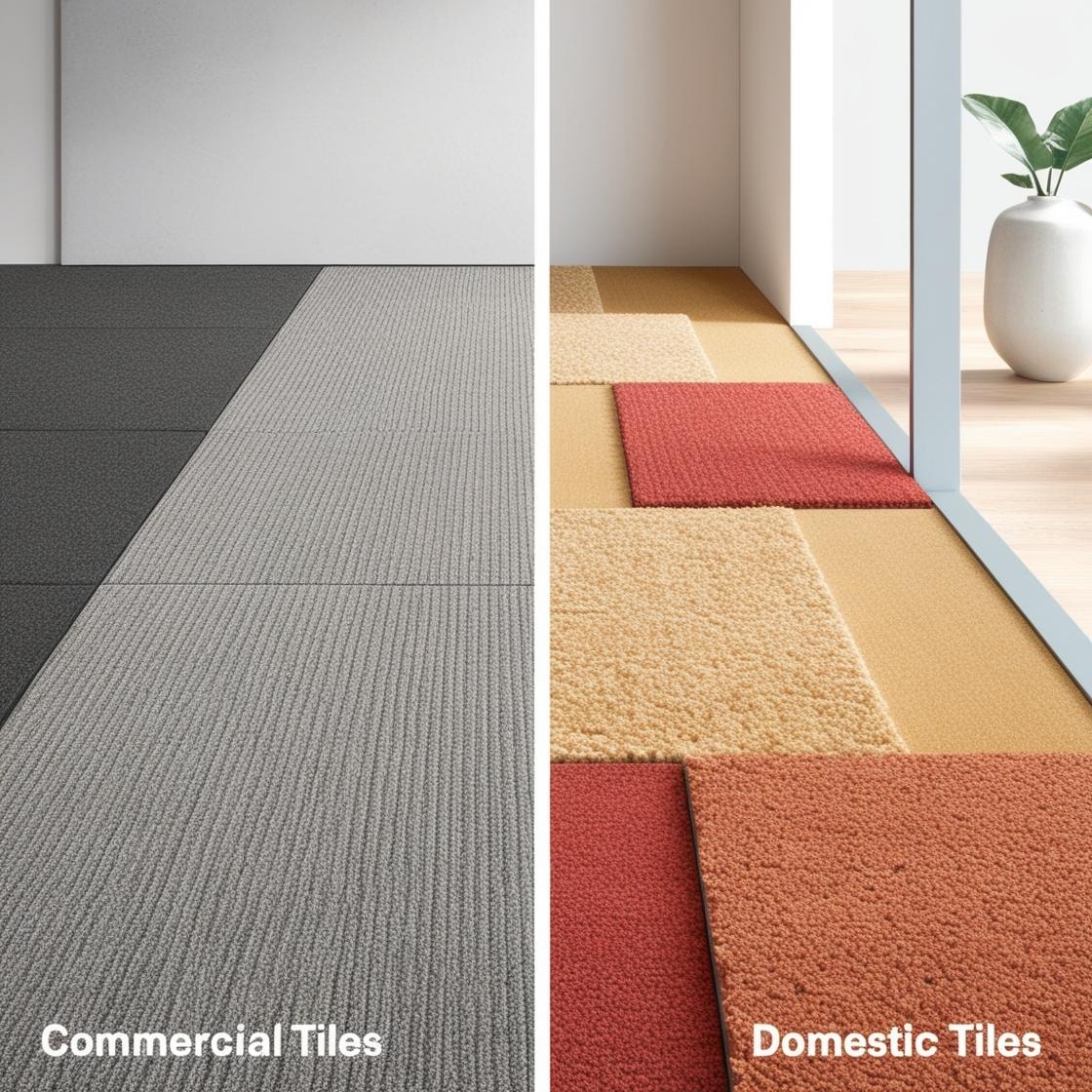The best way to lay carpet tiles in a kitchen is to begin installation from the centre of the room, working outward. This method guarantees a balanced and symmetrical layout, effectively utilising whole tiles in the most visible areas. At the same time, cuts and adjustments are relegated to the perimeter, where cabinets and appliances may obscure them. Properly adhering to the manufacturer's guidelines for adhesive application assures a secure and lasting placement. Further exploration offers additional insight into optimising this process for enhanced functionality and aesthetics.
Key Takeaways
Carpet tiles, also known as modular carpets or carpet squares, are pre-cut tiles made from carpeting material that can be fitted together to cover a floor seamlessly.
Their use in kitchens is favoured due to their ease of installation, ability to withstand heavy foot traffic, and simplicity in replacing individual tiles as opposed to entire flooring.
When compared to other flooring options like ceramic tiles or hardwood, carpet tiles offer enhanced sound dampening and a softer surface, which reduces fatigue during prolonged standing periods typically associated with kitchen tasks.
Understanding the fundamentals of carpet tiles begins with recognising their unique composition and modular design.
These tiles are individual squares of carpet that can be assembled to cover a floor, facilitating straightforward installation and versatility in design. Specifically engineered for spaces like kitchens, these tiles are often stain-resistant and available in various colours and patterns, enhancing both functionality and aesthetic appeal.
The process of laying carpet tiles involves aligning the squares precisely, ensuring each tile interlocks seamlessly with its neighbours. This modularity not only allows for easily fitted installations but also simplifies maintenance, as individual tiles can be replaced without disrupting the entire floor.
This attribute is particularly advantageous in a kitchen, where spills and stains are frequent.

Having explored the basic features, price, and installation process of carpet tiles, it is essential to evaluate their specific advantages when used in kitchen settings.
Carpet tiles offer a practical and versatile flooring solution, particularly attuned to the demands of a kitchen environment. These tiles are specifically engineered to be waterproof and stain-resistant, making them ideal for areas prone to spills and stains.
The durable nature of heavy-duty carpet tiles guarantees they withstand the frequent foot traffic commonly seen in kitchens. In addition, their ease of cleaning is a significant benefit, allowing for straightforward maintenance and hygiene upkeep.
This combination of durability, practicality, and aesthetic versatility makes carpet tiles an advantageous choice for kitchen flooring.
While carpet tiles present numerous benefits for kitchen flooring, it is essential to compare them with other available flooring options to guarantee an informed decision.
Carpet tiles for the kitchen offer ease of installation and replacement, contributing to their practicality in a high-use area. Their modular nature allows for targeted removal and renewal in case of stains or damage, unlike sheet materials, which may necessitate more extensive work.
In addition, carpet tiles enhance warmth and aesthetic appeal, providing style flexibility through various textures and colours.
However, alternatives like ceramic tiles or vinyl offer superior durability and moisture resistance, which are essential in kitchen environments.
Each flooring type integrates distinct characteristics regarding durability, maintenance ease, and visual impact, necessitating careful consideration of lifestyle needs and aesthetic desires.
Selecting the appropriate kitchen carpet tiles involves careful consideration of colour and style options to guarantee aesthetic harmony with existing kitchen decor.
It is vital to evaluate the pile of the carpet, which affects both comfort and durability under frequent kitchen traffic.
Additionally, the backing material must be assessed for moisture resistance and ease of installation, which are fundamental factors for maintaining the tile's longevity and functionality in a kitchen environment.
When choosing the right carpet tiles for a kitchen, it is essential to take into account both colour and style to guarantee they not only complement the interior design but also meet functional requirements.
Selecting a colour that harmonises with the kitchen's aesthetic while offering an illusion of cleanliness is vital. Opt for darker shades or patterns that can effectively mask stains and spills.
Regarding style, consider carpet tiles that are durable, moisture-resistant, and easy to clean. The design should not only align with the overall decor but also withstand the kitchen's high traffic and potential spills.
Aesthetic versatility in carpet tiles allows for customisation, enabling seamless integration with existing kitchen elements and enhancing both functionality and visual appeal.
The selection of carpet tiles for kitchen flooring must prioritise the characteristics of pile and backing due to their critical roles in durability and functionality.
Loop pile carpet tiles, often fabricated from nylon, are particularly suitable for kitchens due to their hard-wearing nature and resistance to damp conditions. Domestic carpet tiles with a dense loop pile offer resilience against kitchen spills and stains, providing a practical yet aesthetically pleasing flooring solution.
Understanding different pile carpet styles helps in choosing the right texture and performance level for a kitchen environment, whether it's a low-profile loop pile for durability or a plush cut pile for added comfort.
The backing of carpet tiles, essential for ensuring proper fit and longevity, should be robust and capable of handling frequent kitchen traffic. Opting for tiles with a thicker backing can enhance comfort and durability.
Prospective buyers should consider obtaining free samples to assess the thickness, weight, and quality of both pile stock and backing before making a purchase decision.
To initiate the process of laying carpet tiles in your kitchen, it is essential first to prepare the floor, ensuring it is clean, level, and dry.
Following preparation, a detailed, step-by-step guide facilitates the precise installation of the tiles, starting from the centre of the room and moving outward.
Awareness of common mistakes, such as Misalignment or inadequate adhesive application, will aid in achieving a professional and durable finish.
Preparing your floor for the installation of carpet tiles in a kitchen requires meticulous attention to detail.
First, confirm the floor surface is impeccably clean; remove all debris, dust, and existing adhesives. This cleanliness is essential for the new adhesive to bond effectively. If there is pre-existing carpet, you may need to detach carpet from concrete carefully to ensure the subfloor is properly exposed and ready for new tile installation.
Next, check the level of the floor. Any unevenness can be rectified using a self-levelling compound, which provides a smooth, flat surface that is important for proper tile laying.
Additionally, it's crucial to assess the floor's moisture levels; excessive moisture can compromise the adhesive's efficacy.
Finally, allow the floor to dry thoroughly after cleaning and levelling before proceeding to lay the carpet tiles. This preparation guarantees a durable and aesthetically pleasing outcome.
After verifying the kitchen floor is clean, level, and dry, homeowners can begin the process of installing carpet tiles.
First, create a layout plan to optimise tile placement and minimise cutting. Start from the centre of the kitchen and work outward, using chalk lines to mark guidelines.
Select moisture-resistant, durable carpet tiles suitable for kitchen environments. Apply adhesive according to the manufacturer's instructions, guaranteeing a tight bond that prevents tile movement.
Press tiles firmly into place, aligning them carefully with the chalk lines. For edges and corners, measure and cut carpet tiles accurately to guarantee a snug fit.
Once installed, press over the tiles again to secure the adhesive. Regular maintenance will keep the tiles looking fresh and extend their lifespan.

Initiating the installation of carpet tiles in your kitchen requires meticulous attention to avoid common pitfalls that can compromise the flooring's functionality and appearance. Proper preparation and application are essential to guarantee a durable, moisture-resistant surface that is easy to clean.
| Common Mistake | Consequence |
|---|---|
| Ignoring humidity levels | Poor adhesive bond, potential mold growth |
| Not cleaning the concrete floor | Weakened adhesion, uneven surface |
| Failing to acclimate carpet tiles | Misalignment and gaps between tiles |
| Skipping vacuum making pre-install | Residual dust hampers tile adherence |
| Neglecting manufacturer guidelines | Suboptimal performance, voided warranty |
Adhering to these guidelines instills a sense of common sense in the installation process, safeguarding the aesthetic and functional integrity of the kitchen flooring for many years.
Maintaining kitchen and bedroom carpet tiles requires adherence to regular cleaning schedules to prevent dirt accumulation and fibre damage.
Immediate attention to spills and stains with appropriate cleaning agents can significantly extend the lifespan of carpet tiles.
It is essential to select cleaners that are specifically designed for carpet tile material to avoid degradation and discolouration. Many retailers offer delivery services for specialised cleaning products, making maintenance even more convenient.
Although carpet tiles in the kitchen offer aesthetic versatility and comfort underfoot, they require regular maintenance to preserve their appearance and extend their lifespan.
Regular maintenance of kitchen carpet tiles involves routine cleaning methods suitable for residential settings. To maintain the robust, hard-wearing nature of these durable flooring solutions, vacuuming should be performed frequently to remove debris and food particles.
Additionally, it is advisable to swap tiles in high-traffic areas with those in the other areas and regions of lower-traffic zones, promoting even wear and extending the overall utility of the carpet tiles.
This maintenance strategy guarantees that the carpet tiles remain clean and visually appealing, thereby supporting their longevity in a typically busy and spill-prone environment like the kitchen.
When spills occur on kitchen carpet tiles, prompt and appropriate action is essential to prevent permanent staining and damage.
Utilising materials such as polypropylene in the manufacture of carpet tiles enhances their durability and ease of maintenance. These fibres are inherently water-resistant, making them ideal for kitchen environments where spills are frequent.
Selecting the appropriate cleaner for kitchen carpet tiles is vital for maintaining their appearance and longevity. When choosing a cleaner, it is imperative to take into account the quality and durability of the product to ensure it effectively cleans without damaging the tiles.
A professional-grade cleaner offers numerous advantages, including compatibility with varied types of carpet tiles and safety for the kitchen environment. Opt for cleaners specifically designed for carpet tiles to prevent residue that can attract dirt or degrade tile fibres.
Maintenance involves routine cleaning with the chosen solution to preserve the tiles' aesthetic and functional qualities. This approach guarantees a durable, clean kitchen floor, enhancing both the visual appeal and hygiene of the space.
Heavy-duty carpet tiles, designed to withstand high levels of foot traffic, offer significant durability and are often used in commercial settings.
When considering these tiles for kitchens, it is vital to compare their characteristics with those of domestic carpet tiles, which may offer different aesthetic and maintenance features.
This comparison is essential in determining whether the robust nature of commercial-grade tiles meets the practical and stylistic requirements of residential kitchen environments.
In high-traffic areas such as kitchens, the durability of flooring materials is paramount. Heavy-duty carpet tiles emerge as a superior choice, offering our customers a blend of functionality and aesthetic appeal.
Here is why they stand out:
While heavy-duty carpet tiles offer robust features for high-traffic kitchen settings, it is essential to differentiate these from their domestic counterparts to determine the most suitable option for residential kitchens.
Commercial carpet tiles are engineered for extreme durability and enhanced moisture resistance, making them ideal for areas with significant traffic patterns and potential spillage.
Conversely, domestic carpet tiles prioritise aesthetic appeal and comfort, incorporating softer textures and varied designs suitable for home environments.
Installation and maintenance practices also differ; commercial tiles typically require less frequent replacement due to their resilient nature.
However, for a balance of durability and aesthetics, homeowners might consider commercial-grade tiles designed with a domestic look to achieve peak performance and style in kitchen applications.
When selecting carpet tiles for a kitchen, it is essential to take into account both aesthetic appeal and functionality.
Trendy colours may include neutral tones that can easily blend with various kitchen decors, while more vibrant options can serve as focal points.
Popular styles often feature stain-resistant and durable materials, ensuring longevity and ease of maintenance in a high-traffic area.
Selecting the appropriate colours and styles for kitchen carpet tiles should align with both contemporary trends and the functional needs of the space.
To guarantee that the chosen tiles complement the existing decor and enhance the overall aesthetic of the room, consider the following:
Popular styles of kitchen carpet tiles often reflect both functionality and aesthetic appeal, catering to diverse preferences and requirements.
For peak utility, the tiles you need should be durable and easy to clean, characteristics often found in office-grade carpeting, which can also be suitable for kitchen environments.
Cheap carpet tiles offer a convenient, budget-friendly option without compromising on style. These tiles come in various shapes, allowing for creative layouts that can add a distinctive touch to kitchen decor.
While not traditionally used, bathroom carpet tiles are gaining traction in kitchens due to their moisture-resistant qualities.
Selecting the perfect style involves considering both practical aspects and the visual integration with existing kitchen aesthetics.

To effectively match carpet tiles with kitchen decor, homeowners should consider both the dominant colour schemes and the overall style of their kitchen.
Here's how to choose the best styles and colours:
In summary, selecting and installing carpet tiles in a kitchen requires careful consideration of material durability and ease of maintenance. Opt for heavy-duty tiles that can withstand high traffic and potential spills. Installation should follow a precise, methodical approach to guarantee alignment and adhesion. Once installed, regular cleaning and maintenance are essential to preserve the aesthetic appeal and functionality of the tiles. Choosing appropriate styles and colours enhances the overall kitchen decor while assuring practicality.